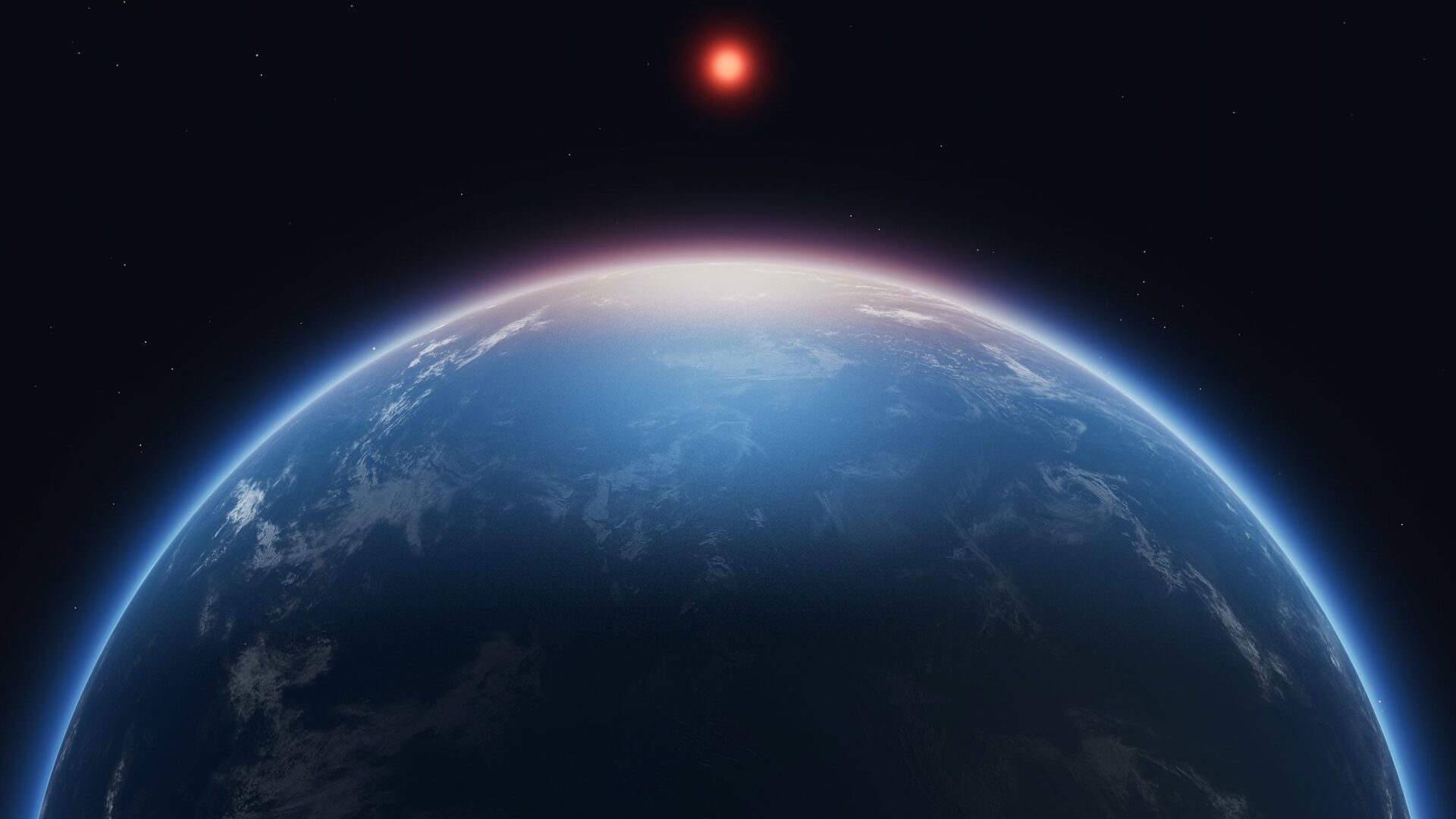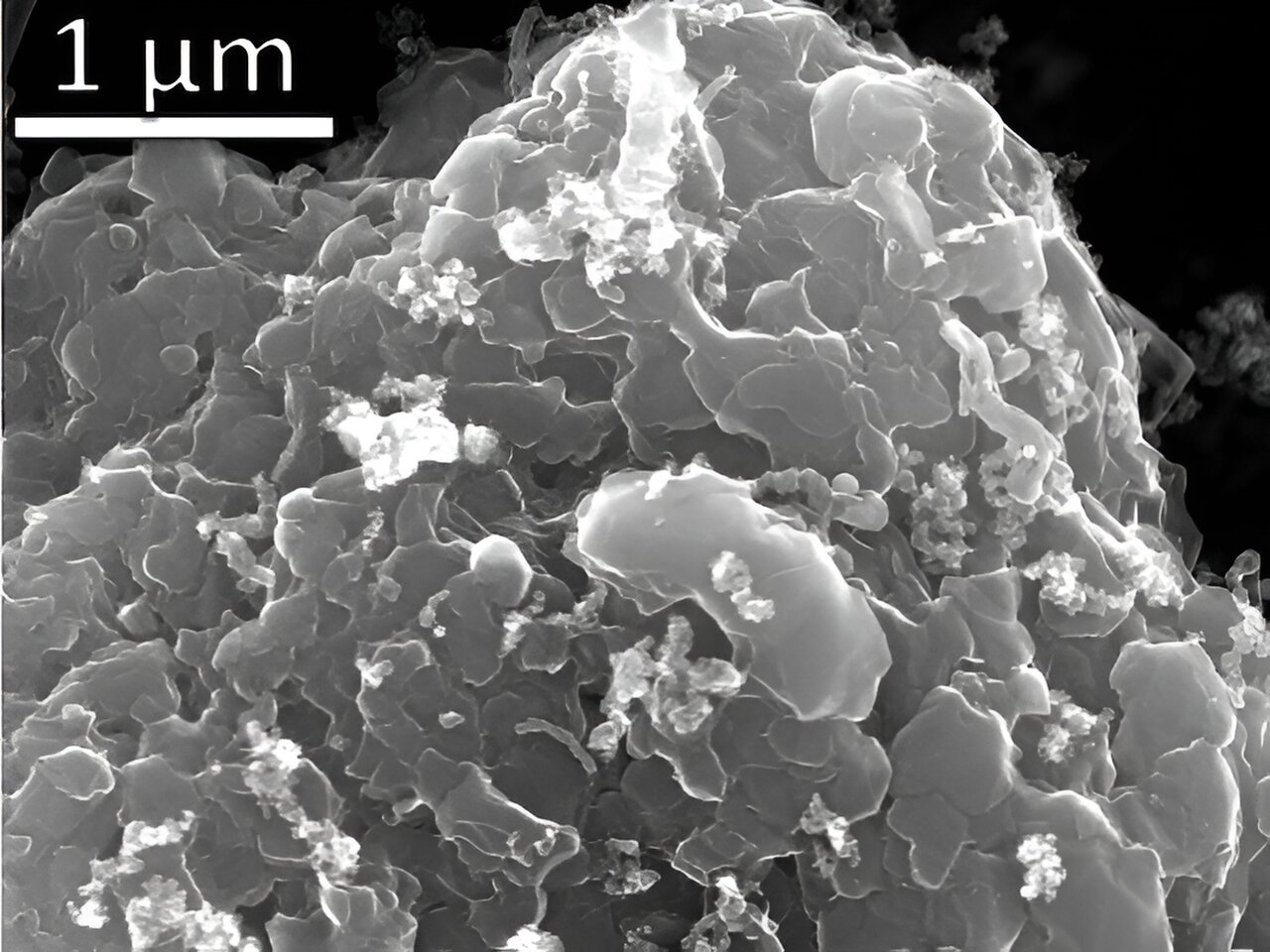
via University of Cambridge
An international team of astronomers led by the University of Cambridge has used data from the NASA/ESA/CSA James Webb Space Telescope to discover methane and carbon dioxide in the atmosphere of K2-18 b, an exoplanet in the ‘Goldilocks zone’. This is the first time that carbon-based molecules have been discovered in the atmosphere of an exoplanet in the habitable zone.
The results are consistent with an ocean-covered surface underneath a hydrogen-rich atmosphere. The discovery provides a glimpse into a planet unlike anything else in our Solar System, and raises interesting prospects about potentially habitable worlds elsewhere in the Universe.
K2-18 b — which is 8.6 times as massive as Earth — orbits the cool dwarf star K2-18 in the habitable zone and lies 110 light years from Earth in the constellation of Leo. A first insight into the atmosphere of K2-18 b came from observations with the Hubble Space Telescope but the atmospheric composition has been a subject of debate. The same researchers studied K2-18 b in 2020 and 2021, and identified it as belonging to a new class of habitable exoplanets called ‘Hycean’ worlds which could accelerate the search for life elsewhere. This prompted them to take a more detailed look with JWST, Hubble’s successor.
Using JWST’s higher resolution instruments, this new investigation has definitively identified methane and carbon dioxide in a hydrogen-rich atmosphere on K2-18 b.
The researchers also identified another, weaker, signal in the K2-18 b spectrum. After several analyses, the researchers say that the signal could be caused by a molecule called dimethyl sulphide (DMS). On Earth, DMS is only produced by life, primarily microbial life such as marine phytoplankton, suggesting the possibility of biological activity on K2-18 b. While these signs of DMS are tentative and require further validation, the researchers say that K2-18 b and other Hycean planets could be our best chance to find life outside our Solar System.
The results, which have been accepted for publication in The Astrophysical Journal Letters, will be presented today (11 September) at the First Year of JWST Science Conference in Baltimore, Maryland, USA.
Exoplanets such as K2-18 b, which have sizes between those of Earth and Neptune, are unlike anything in our Solar System. This lack of analogous nearby planets means that these ‘sub-Neptunes’ are poorly understood and the nature of their atmospheres is a matter of active debate between astronomers.
“Our findings underscore the importance of considering diverse habitable environments in the search for life elsewhere,” said lead author Professor Nikku Madhusudhan, from Cambridge’s Institute of Astronomy. “Traditionally, the search for life on exoplanets has focused primarily on rocky planets, but Hycean worlds are significantly more conducive to atmospheric observations.”
The abundance of methane and carbon dioxide, and dearth of ammonia, are consistent with the presence of an ocean underneath a hydrogen-rich atmosphere in K2-18 b. The inference of DMS, however, is less robust and requires further validation. “More observations are needed to determine whether it is in fact DMS that we’re seeing,” said Madhusudhan. “The possibility of DMS in the atmosphere is highly promising, but we are planning to take another look to robustly establish its presence.”
While K2-18 b looks like a highly promising candidate in the search for life elsewhere, it is possible that it may not be able to support life. The planet’s large size — with a radius 2.6 times the radius of Earth — means that the planet’s interior likely contains a large mantle of high-pressure ice, like Neptune, but with a thinner hydrogen-rich atmosphere and an ocean surface. It is possible that the ocean is too hot to be habitable or be liquid. More observations and theoretical work are needed to establish this conclusively.
“Although this kind of planet does not exist in our Solar System, sub-Neptunes are the most common type of planet known so far in the galaxy,” said co-author Subhajit Sarkar of Cardiff University. “We have obtained the most detailed spectrum of a habitable-zone sub-Neptune to date and this allowed us to work out the molecules that exist in its atmosphere.”
Characterising the atmospheres of exoplanets like K2-18 b — meaning identifying their constituent gases and physical conditions — is an area of frenzied activity in astronomy. Determining the chemicals present in the atmospheres of exoplanets is vital to understanding these alien worlds and provides tantalising hints about habitability elsewhere in the Universe. However, these planets are outshone — literally — by the glare of their much larger parent stars, which makes exploring exoplanet atmospheres challenging.
The team sidestepped this challenge by analysing light from K2-18 b’s parent star as it passed through the exoplanet’s atmosphere. K2-18 b is a transiting exoplanet, meaning that we can detect a drop in the stellar brightness as it passes across the face of its host star. This is how the exoplanet was first discovered in 2015. This means that during transits a tiny fraction of starlight will pass through the exoplanet’s atmosphere before reaching Earth. The starlight’s passage through the atmosphere leaves ghostly traces in the stellar spectrum that astronomers can piece together to determine the constituent gases of the exoplanet’s atmosphere.
“This result was only possible because of the extended wavelength range and unprecedented sensitivity of Webb, which enabled robust detection of spectral features with just two transits,” said Madhusudhan. “For comparison, one transit observation with Webb provided comparable precision to eight observations with Hubble conducted over a few years in a shorter wavelength range.”
“These results are the product of just two observations of K2-18 b, with many more on the way,” said co-author Savvas Constantinou, also from Cambridge’s Institute of Astronomy. “This means our work here is but an early demonstration of what Webb can observe in habitable zone exoplanets.”
The team now intends to conduct follow-up research that they hope will further validate their findings and provide new insights into the environmental conditions on K2-18 b. The team’s next round of Webb observations will use the telescope’s Mid-InfraRed Instrument (MIRI) spectrograph to scour K2-18 b’s atmosphere for tell-tale chemical signatures called biomarkers, including DMS, which could potentially indicate the presence of biological activity.
“Our ultimate goal is the identification of life on a habitable exoplanet, which would transform our understanding of our place in the Universe,” said Madhusudhan. “Our findings are a promising first step in this direction.”
Original Article: Methane and carbon dioxide found in atmosphere of habitable-zone exoplanet
More from: University of Cambridge
The Latest Updates from Bing News
Go deeper with Bing News on:
Search for extraterrestrial life
- ‘Is it aliens?’: how a mysterious star could help the search for extraterrestrial life
Scientists hope studies into Boyajian’s star could lead to enhanced techniques for identifying distant planetary civilisations ...
- ‘We live in a golden time of exploration’: astronomer Lisa Kaltenegger on the hunt for signs of extraterrestrial life
Astronomer Lisa Kaltenegger has spent her life hunting for signs of life in the universe. Here she tells Emma Beddington about aliens, space exploration and why studying cosmology is like eating pizza ...
- The search for extraterrestrial life: where are they?
The following gallery outlines some of the existing theories that attempt to explain why we haven't yet established real contact with potential extraterrestrial life. Check it out!
- Gaiasignatures: A New Way to Search for Extraterrestrial Life
Hunting for life on other planets is hard; it’s like trying to spot an ant on the other end of a football field. The closest potential host, Venus, is 25 million miles away. Beyond our Solar Sys ...
- Astrophysicist says that discovery of alien life could be ‘just a couple of years away’
Astrophysics professor Lisa Kaltenegger is leading the charge in one of humanity’s most captivating endeavors — the search for life beyond Earth.
Go deeper with Bing News on:
Habitable exoplanet
- Extrasolar Planets News
According to the study's authors, there are ... Newly Discovered Carbon Monoxide-Runaway Gap Can Help Identify Habitable Exoplanets Feb. 6, 2024 — A carbon monoxide (CO)-runaway gap identified ...
- NASA discovered a planet twice as big as Earth with a gas that is 'only produced by life'
NASA's James Webb Telescope picked up a 'possible detection' of a molecule which 'on Earth is only produced by life' on an exoplanet twice as big as ours ...
- Alien Discovery Coming Up? Traces Of Gas Produced By Life Here Found On 'Super-Earth'
A discovery recently made by a few astronomers could soon prove to be the biggest one ever. We might be a few months from confirming whether an exoplanet is capable of hosting alien life. Target in ...
- Webb studies planet K2-18 b again to confirm presence of gas ‘only produced by life'
K2-18 b is an exoplanet that has recently captured the attention of astronomers due to the presence of intriguing DMS gas molecules in its atmosphere.
- Why alien life might look purple
Instead of using chlorophyll, the green organelle that most plants have today used for photosynthesis, purple bacteria uses bacteriochlorophyll and carotenoids, which allows them to perform ...










